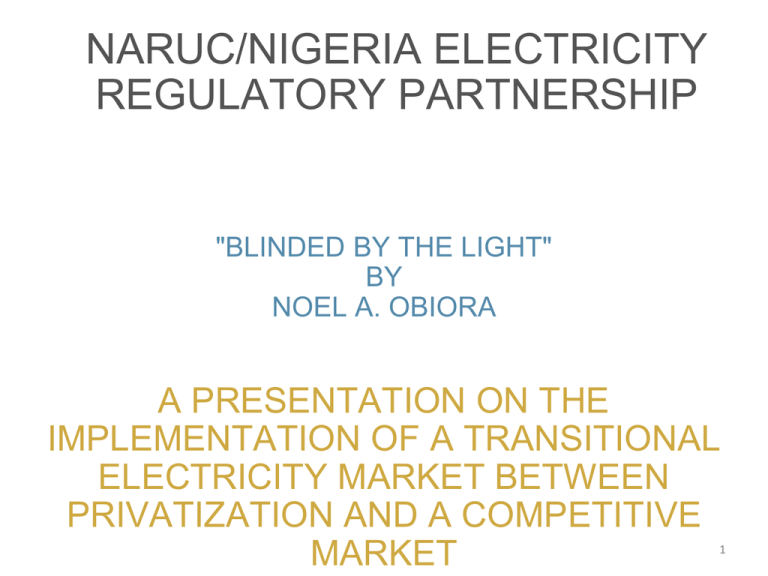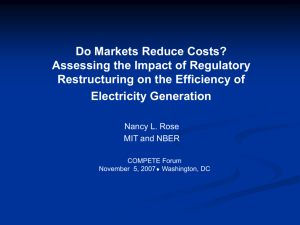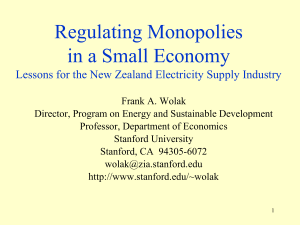Implementation of a Transitional Electricity Market
advertisement

NARUC/NIGERIA ELECTRICITY REGULATORY PARTNERSHIP "BLINDED BY THE LIGHT" BY NOEL A. OBIORA A PRESENTATION ON THE IMPLEMENTATION OF A TRANSITIONAL ELECTRICITY MARKET BETWEEN PRIVATIZATION AND A COMPETITIVE MARKET 1 DISCLAIMER The opinions expressed in this presentation are those of the author, not necessarily the opinions of the California Public Utilities Commission A NOTE ON THE TITLE The title of this presentation was borrowed from an article by Mary Bushnell on restructuring; as used in this presentation, it is intended to reflect the notion that, that those who see an unfettered free market competition as the panacea for all that ails regulated electricity monopoly companies are blinded by the light, because restructuring holds on to and embraces effective regulation 2 PRESENTATION OUTLINE 1. Basic architecture of all models for restructured electricity markets 2. Basic architecture of Nigeria's restructuring model 3. Applying traditional restructuring architecture in the African Context 4. Examining the gap between the current state of privatization and the objective end state of competition in Nigeria 5. What should a transitional electricity market consist of? 6. Conclusion 3 THE BASIC ARCHITECTURE OF ALL MODELS FOR RESTRUCTURED ELECTRICITY MARKETS • Vertical Separation of Generation, Distribution, Transmission Segments – • Horizontal Integration of Transmission and Network Operations Covering the Geographic Area of the Intended Wholesale Market • Creation of Wholesale Spot Energy and Operating Reserve Markets to Serve the Network • Creation of Relevant Institutions to Facilitate and Oversee Access To Network, Market Operations, Forward Supply Commitments … • Unbundling Retail Tariffs to Reflect the Separated Segments Vertical Separation • Most Critical Element of Restructuring • Generation – Privatized and made competitive; – Focus on development of forward market • Transmission – Government or privately owned, but regulated – Focus on building networks to facilitate market • Distribution – Privately owned but regulated – Focus on expanding network access to facilitate free flow HORIZONTAL INTEGRATION; WHOLESALE SPOT MARKET; INSTITUTIONS; UNBUNDLING TARIFFS • Single Independent System Operator – Dispatch functions vs. Market Operations – Transmission planning and costing, Congestion Management, Responsibility for reliability • Determining the Model for Pricing – Load Aggregated Pricing; Ex-post Pricing; Exante Pricing • Market Monitoring, Rules; Market Power Mitigation – Establishing Market Rules and Market Power Mitigation and Other Opportunistic Behavior • Effective, Alert, Fully Staffed Institutions RE-TOOLING THE BASIC ARCHITECTURE OF THE RESTRUCTURING MODEL “Any market you start with is going to be the wrong market. That has been the case everywhere there was “If you are not cheating you a market” are not trying to win” Frank Wolak Holbrook Working Professor of Commodity Price Studies, Department of Economics Stanford University Marty McSorley Professional Hockey Player BASIC ARCHITECTURE OF NIGERIA’S RESTRUCTURING MODEL • MARKET RULES 6.3 – 6.3.1 All electricity trading arrangements during the Transitional Stage will be consummated through contracts, and there will be no centrally administered balancing mechanism for the Transitional State Market – 6.3.2 The Market Operator shall develop a Market Procedure for management of inadequate supply and shortage conditions during the Transitional Stage. This Market Procedure will allocate generation shortages proportionally among Load Participants and will be tested and improved during the Transitional Stages, and shall become part of the Grid Code at the start of the Medium Term Market • (a) This allocation of generation shortages shall take account of Load Participations’ contractual rights APPLYING TRADITIONAL RESTRUCTURING ARCHITECTURE IN AFRICA 1. TECHNOLOGICAL CHALLENGE 2. INSTITUTIONAL CHALLENGES 3. BARRIERS TO ENTRY 4. RURAL FLIGHT AND URBAN CONGESTION 9 TECHNOLOGICAL CHALLENGE - THE AFRICAN CONTEXT The very attributes of electricity, such as that it can’t be stored, must be delivered in as close to real time as possible, which involves managing known generation to address uncertainties coupled with known demand, technical demands of addressing imbalances and loop characteristics of Network systems that require clearing purchases at several nodal points make the transition to a wholesale competitive industry a very technical challenge in the developed world. In Africa this challenge is even more daunting. 10 INSTITUTIONAL CHALLENGES The development of competitive wholesale markets requires the establishment of several new functioning institutions that did not exist with regulated monopolies, in place of entrenched bureaucratic interests that may not relinquish their roles too easily or may do so by influencing the design to carve out and retain some aspects of the new institution’s roles in a different guise. Forming one of these institutions is difficult enough but creating three or four while the regulator itself is a nascent development is very challenging. Much of the problems of transitioning from traditional monopolies to restructured markets in America have come from political pressures that forced deviations from otherwise known architecture to result in flawed processes designed more by lobbyists and labour unions than by regulators and economists. One study suggested that in every state where wholesale markets were adopted, Enron was heavily involved 11 in lobbying State politicians to influence the design BARRIERS TO ENTRY BARRIERS TO ENTRY ENSURE THAT ENTITIES AND INDIVIDUALS CAPABLE OF ACQUIRING THE PRIVATIZED UTILITIES ARE THEMSELVES RICH POWERFUL “INSTITUTIONS” THAT CAN EXERT POLITICAL AND ECONOMIC PRESSURES OF THEIR OWN; WITH A LARGE VULNERABLE CLASS OF RATEPAYERS AND LOW PER CAPITA INCOMES ACROSS THE COUNTRIES, THE ABILITY OF THESE INSTITUTIONS TO INFLUENCE THE NEW MARKET GOES BEYOND “MARKET POWER MANIPULATIONS” AND REQUIRE A STRONG AND DEDICATED REGULATOR TO PROTECT RATEPAYERS RURAL FLIGHT AND URBAN CONGESTION THE DISTRIBUTION OF POPULATION IN AFRICA MOSTLY ALONG ECONOMIC NEEDS WITH SPARSE RURAL POPULATIONS AND LARGE URBAN POPULATIONS MEANS THAT EXISTING ELECTRICITY INFRASTRUCTURE WOULD HAVE BEEN DESIGNED FROM A PERSPECTIVE FAR FROM THE COMPETITIVE RESTRUCTURED MARKET CURRENTLY BEING INTRODUCED AND DELIBERATE CONSIDERATION MUST BE MADE TO UNDERSTAND THE IMPLICATIONS, NOT JUST FROM A LEGACY TRANSMISSION INFRASTRUCTURE PERSPECTIVE, BUT IN CONSIDERING WHO PAYS FOR THE DEVELOPMENT OF NEW INFRASTRUCTURE AND HOW THE GAP BETWEEN CURRENT STATE OF PRIVATIZATION AND COMPETITION 1. 2. 3. 4. 5. 6. UNIQUE NATURE OF NIGERIA’S TRANSITION THE GOAL OF RESTRUCTURING RESOURCE ADEQUACY INSTITUTIONAL CHALLENGES BUILDING INVESTOR CONFIDENCE RESOLUTIONS: THINKING OUTSIDE THE BOX THE GOAL OF RESTRUCTURING • BRING BENEFITS OF COMPETITIVE WHOLESALE MARKETS TO CONSUMERS: – LOWER TRANSMISSION AND GENERATION COSTS • More efficient transmission network platforms because the must be kept at optimum performance level to deliver an effective market conditions • Breaking up component segments of the electricity markets make market signals for the investment in each segment clearer and distinguishable – By contrast regulated monopolies are forever robbing Peter to pay Paul • SHIFT CERTAIN RISKS APPROPRIATELY TO PRODUCERS • ATTRACT INVESTMENT IN NEW INFRASTRUCTURE • ELIMINATE INEFFICIENCY GAP ANALYSIS OF TRANSMISSION AND DISTRIBUTION COSTS • LEGACY TRANSMISSION ISSUES – COST OF DEVELOPING EFFICIENT NETWORK • INVESTMENT DECISION DRIVEN BY POLITICAL PRESSURES RATHER THAN MARKET SIGNALS – WHAT IS THE TRUE MARGINAL COST OF DISTIRBUTION PLANTS THAT SHOULD BE PASSED ON TO RATEPAYERS • LACK OF EMPERICAL DATA – EXPONENTIALLY INCREASES THE PROBLEM OF ASSYMETRIC INFORMATION • EMPERICAL DATA RESOURCE ADEQUACY Resource adequacy measures the amount of capacity necessary to maintain reliability on the system in real time within a particular time frame, measured as a percentage of Peak Load. Consists of: 1) Operating Reserves; and 2) Planning Reserves. • Operating Reserves = Sufficient capacity to meet peak demand (+) reserves for unplanned outages [(Dependable Capacity – Reasonably Expected Resource Outages)/Peak Load] – 1} x 100%. • Planning Reserves = Operating Reserves over the long-term + Reasonably Expected Outages, which then includes planning for additional uncertainties such as hot weather PRM = [ (Dependable Capacity/Peak Load) – 1] x 100% RESERVE MARGIN The delta between the amount of resources necessary to achieve resource adequacy and the amount of resource necessary to meet Peak Load is the reserve margin Factors Modeled In Determining Reserve Margin Include: 1. 2. 3. 4. 5. Historical Plant Outage Rates; Size of Plants; Thermal De-rates; Weather Conditions; Transmission Contingencies Plant as used here refers also to transmission lines INSTITUTIONAL CHALLENGES NIGERIA • Regulated vs. Competitive Segments – Are institutions sufficiently staffed and equipped to address the needs of these different segments – Jurisdictional Considerations in the American Context – Economic Strength Considerations in Nigeria – [The Enron Problem] • Divestiture vs. Operational Boundaries – Incentives for New Generation Resources – “Chinese Wall” – Hybrid Markets and Utility Ownership of Transmission • Regulatory Commission vs. Bulk Trader – Administration of Contracts of Regulated Entities – Planning and Approval of Needed Generation – Allocation of costs and scarcity INESTOR CONFIDENCE “Ambiguities in retail procurement responsibilities, competitive retail market imperfections and regulatory opportunism and uncertainty affects contracting incentives and behavior and leads to too much short-term forward contracting and too little long term contracting. This undermines the development of liquid forward markets for energy and operating reserves which in turn reduces the ability of investors in new generating capacity to hedge market risks and increases their financing costs above what they would be if consumer and supplier risk preferences could be better matched.” Paul Joskow Professor, Massachusetts Institute of Technology RESOLUTION: THINKING OUTSIDE THE BOX • IN TANZANIA THE MARKET PRICE OF GAS IS BASED ON THE NEW YORK MERCANTILE EXCHANGE BOARD (NYMEX) INDEX • RURAL FLIGHT AND URBAN CONGESTION: WOULD RELOCATION OF GOVERNMENTAL FACILITIES FROM CONGESTED CAPITALS TO RURAL AREAS HELP ADDRESS THE INFRASTRUCTURE GAP BETWEEN RURAL AND URBAN AREAS • RURAL FLIGHT AND URBAN CONGESTION: INSISTING THAT UTILITY CUSTOMER SERVICE CENTERS MUST BE LOCATED WITHIN PARTICULAR DISTANCES OF SERVED POPULATION • COORDINATING WITH OTHER AGENCIES AND POLICY MAKERS IN OTHER AREAS WHOSE DECISIONS MIGHT AFFECT THE POPULATION IN WAYS THAT INCREASE THE VALUE STREAM OF NASCENT ELECTRICITY UTILITIES, THEREBY SUBSIDIZING THE COST TO THE VULNERABLE POPULATION • REDEFINING RESOURCE ADEQUACY AND ESTABLISHING STEPS FOR ATTAINING A TRADITIONAL RESERVE MARGIN AS A PERCENTAGE OF PEAK LOAD AS TIME GOES ON WHAT SHOULD A TRANSITIONAL ELECTRICITY MARKET LOOK LIKE • READINESS AND COORDINATION OF GOVERNANCE INSTITUTIONS • TRANSPERENT SCHEDULES • REGULAR STAKEHOLDER CONSULTATION AND UPDATES • DATA ADEQUACY • NETWORK AND INFRASTRUCTURE TEST RUNS OF THE MARKET DESIGN • MEDIUM TO LONG-TERM PLAN SCHEDULES FOR ENSURING THE EXISTENCE AND VIABILITY OF A LONG-TERM FORWARD MARKET 22 CONCLUSION “Electricity restructuring and competition programs have inevitably been a process that invites a lot of learning by doing and ongoing challenges to market rules, regulatory arrangements and governance institutions” Paul Joskow MIT











